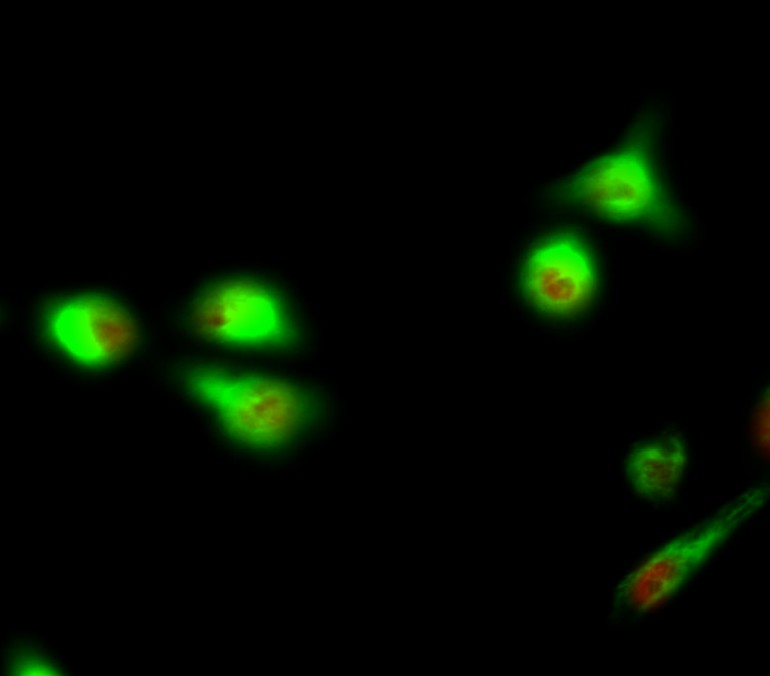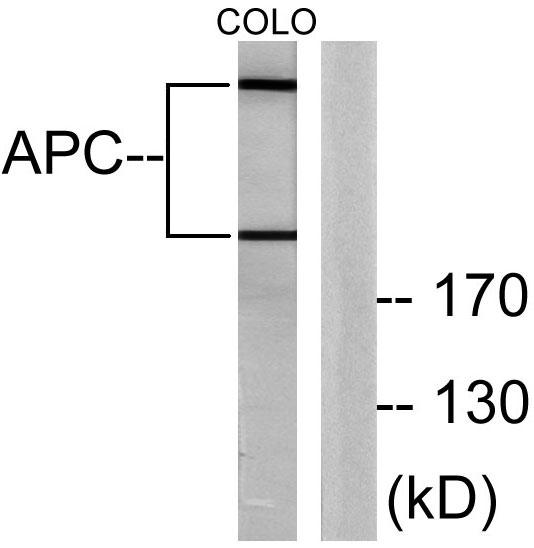APC Polyclonal Antibody
- Catalog No.:YT0258
- Applications:WB;IHC;IF;ELISA
- Reactivity:Human;Mouse;Rat
- Target:
- APC
- Fields:
- >>Wnt signaling pathway;>>Hippo signaling pathway;>>Signaling pathways regulating pluripotency of stem cells;>>Regulation of actin cytoskeleton;>>Cushing syndrome;>>Alzheimer disease;>>Pathways of neurodegeneration - multiple diseases;>>Human papillomavirus infection;>>Pathways in cancer;>>MicroRNAs in cancer;>>Colorectal cancer;>>Endometrial cancer;>>Basal cell carcinoma;>>Breast cancer;>>Hepatocellular carcinoma;>>Gastric cancer
- Gene Name:
- APC
- Protein Name:
- Adenomatous polyposis coli protein
- Human Gene Id:
- 324
- Human Swiss Prot No:
- P25054
- Mouse Swiss Prot No:
- Q61315
- Rat Gene Id:
- 24205
- Rat Swiss Prot No:
- P70478
- Immunogen:
- The antiserum was produced against synthesized peptide derived from human APC. AA range:2794-2843
- Specificity:
- APC Polyclonal Antibody detects endogenous levels of APC protein.
- Formulation:
- Liquid in PBS containing 50% glycerol, 0.5% BSA and 0.02% sodium azide.
- Source:
- Polyclonal, Rabbit,IgG
- Dilution:
- WB 1:500 - 1:2000. IHC 1:100 - 1:300. IF 1:200 - 1:1000. ELISA: 1:40000. Not yet tested in other applications.
- Purification:
- The antibody was affinity-purified from rabbit antiserum by affinity-chromatography using epitope-specific immunogen.
- Concentration:
- 1 mg/ml
- Storage Stability:
- -15°C to -25°C/1 year(Do not lower than -25°C)
- Other Name:
- APC;DP2.5;Adenomatous polyposis coli protein;Protein APC;Deleted in polyposis 2.5
- Observed Band(KD):
- 310kD
- Background:
- This gene encodes a tumor suppressor protein that acts as an antagonist of the Wnt signaling pathway. It is also involved in other processes including cell migration and adhesion, transcriptional activation, and apoptosis. Defects in this gene cause familial adenomatous polyposis (FAP), an autosomal dominant pre-malignant disease that usually progresses to malignancy. Disease-associated mutations tend to be clustered in a small region designated the mutation cluster region (MCR) and result in a truncated protein product. [provided by RefSeq, Jul 2008],
- Function:
- disease:APC mutations have led to some interesting observations. (1) the great majority of the mutations found to date would result in truncation of the APC product. (2) almost all the mutations have occurred within the first half of the coding sequence, and somatic mutations in colorectal tumors are further clustered in a particular region, called MCR (mutation cluster region). (3) most identified point mutations in the APC gene are transitions from cytosine to other nucleotides. (4) the location of germline mutations tends to correlate with the number of colorectal polyps in FAP patients. Inactivation of both alleles of the APC gene seems to be required as an early event to develop most adenomas and carcinomas in the colon and rectum as well as some of those in the stomach.,disease:Defects in APC are a cause of familial adenomatous polyposis (FAP) [MIM:175100]; which includes also Gard
- Subcellular Location:
- Cell junction, adherens junction . Cytoplasm, cytoskeleton . Cell projection, lamellipodium . Cell projection, ruffle membrane . Cytoplasm . Cell membrane . Associated with the microtubule network at the growing distal tip of microtubules (PubMed:19632184). Accumulates in the lamellipodium and ruffle membrane in response to hepatocyte growth factor (HGF) treatment (PubMed:19151759). The MEMO1-RHOA-DIAPH1 signaling pathway controls localization of the phosphorylated form to the cell membrane (PubMed:20937854). .
- Expression:
- Expressed in a variety of tissues: brain, small intestine, colon, thymus, skeletal muscle, heart, prostate, lung, spleen, ovary, testis kidney, placenta, blood and liver (PubMed:21643010, PubMed:27217144). Isoform 1A: Very strongly expressed in brain but has relatively low expression levels in other tissues (PubMed:19527921, PubMed:21643010, PubMed:27217144). Isoform 1B: Predominant form in all tissues except for brain, including gastric mucosa and blood (PubMed:19527921, PubMed:21643010, PubMed:27217144).
Increased oligodendrogenesis by humanin promotes axonal remyelination and neurological recovery in hypoxic/ischemic brains. HIPPOCAMPUS 2014 Sep 10 IF Rat striatum
The Oncogenic Role of miR-BART19-3p in Epstein-Barr Virus-Associated Diseases. Biomed Research International Biomed Res Int. 2020;2020:5217039 WB Human CNE2 cell
- June 19-2018
- WESTERN IMMUNOBLOTTING PROTOCOL
- June 19-2018
- IMMUNOHISTOCHEMISTRY-PARAFFIN PROTOCOL
- June 19-2018
- IMMUNOFLUORESCENCE PROTOCOL
- September 08-2020
- FLOW-CYTOMEYRT-PROTOCOL
- May 20-2022
- Cell-Based ELISA│解您多样本WB检测之困扰
- July 13-2018
- CELL-BASED-ELISA-PROTOCOL-FOR-ACETYL-PROTEIN
- July 13-2018
- CELL-BASED-ELISA-PROTOCOL-FOR-PHOSPHO-PROTEIN
- July 13-2018
- Antibody-FAQs
- Products Images

- Immunofluorescence analysis of Hela cell. 1,APC Polyclonal Antibody(red) was diluted at 1:200(4° overnight). Galectin-3 Monoclonal Antibody(6G2)(green) was diluted at 1:200(4° overnight). 2, Goat Anti Rabbit Alexa Fluor 594 Catalog:RS3611 was diluted at 1:1000(room temperature, 50min). Goat Anti Mouse Alexa Fluor 488 Catalog:RS3208 was diluted at 1:1000(room temperature, 50min).

- Western Blot analysis of various cells using APC Polyclonal Antibody diluted at 1:500
.jpg)
- Western Blot analysis of COLO205 cells using APC Polyclonal Antibody diluted at 1:500

- Immunohistochemistry analysis of paraffin-embedded human colon carcinoma tissue, using APC Antibody. The picture on the right is blocked with the synthesized peptide.

- Western blot analysis of lysates from COLO205 cells, using APC Antibody. The lane on the right is blocked with the synthesized peptide.



